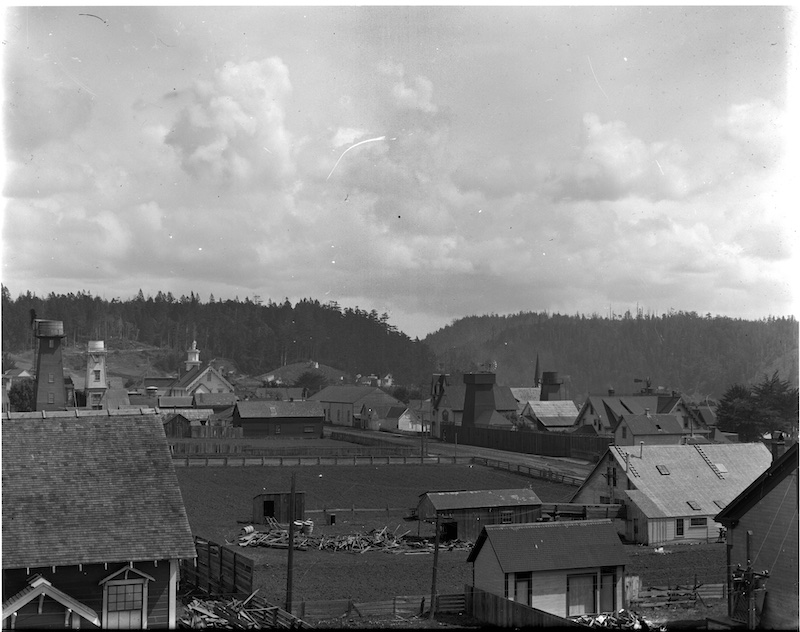An elevated view along Ukiah Street looking southeastward, taken from Perley Maxwell’s water tower on Calpella Street near Kasten, 1912 – 1922. The building on the left is Apple Hall, built in 1912 and removed in 1944. Beyond it is the very tall Hagenmeyer water tower and J. D. Johnson’s tower to its right, both now also gone. The Masonic Hall with its rooftop statuary is near the center of the image, and to the right of it is the rear and north side of Nichols’ Show House in what would become Kellieowen Hall at the corner of Ukiah and Lansing Streets. Faintly seen between these two structures is the west end of the Stauer House on Ukiah Street, which would later become Frankie’s Pizza. In 1922, Rev. Smith would build in front of the Stauer House his Gospel Hall (later the Sea Gull Restaurant) on the corner of Ukiah and Lansing, but Smith’s place is not present in this image.

Looking right, the Kelley Baptist Church and steeple are visible, and then to the right is a shingle-covered water tower with a windmill located at the rear of the MacCallum House, right. Beyond these a plain tank tower associated with the Boyd & Daniels Livery Stable sits near the corner of Albion and Lansing Streets. The Kelley House water tower and windmill are partially visible behind the MacCallum House.
The building on the right with ladders on the roof is the Mendocino Beacon building on Ukiah Street. The long shed extending off the rear of the main building housed a engine for sawing wood, and the small building near the wood pile is for storing the flammable gasoline fuel away from the other buildings.
In the right foreground, the small building with two entrances is the outhouse (still standing in 2023) belonging to the Odd Fellows Hall, which is partially visible to its right. (Gift of Emery Escola, Photographer: Perley Maxwell)
A Mendocino Remembrance by Mendocino native John Preston Fraser. This charming memoir brings to life the unique place that was the town of Mendocino, California before it became the artist colony and tourist destination for which it is well known today. During the 1940s, Mendocino was a quiet community of unpaved roads and Victorian-era architecture perched on bluffs above the Pacific Ocean. Fraser’s reminiscences are accompanied by vintage photographs from the Kelley House Museum archives paired with contemporary color images taken by photographer Jamie Armstrong, offering readers an enjoyable “Then and Now” view of Mendocino. $35